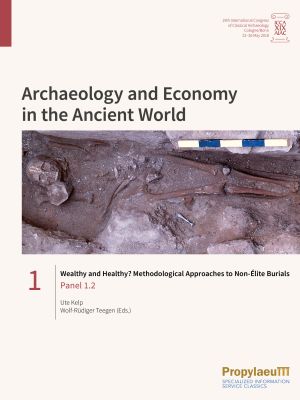Teegen, Wolf-Rüdiger
Wealthy and Healthy? Methodological Approaches to Non-Élite Burials: Panel 1.2
Die Analyse antiker Gesellschaften jenseits politischer Systeme, Hauptakteure und Eliten ist in hohem Maße auf archäologische Hinterlassenschaften angewiesen. Zahlreich erhalten sind Gräber und Grabdenkmäler, die als Primärzeugnisse eine aussagekräftige antike Quellengattung darstellen. Allerdings können Nekropolen und Bestattungen weder als Spiegel sozialer Verhältnisse gewertet werden, noch ist eine dichotomische Darstellung der Gesellschaft als Gegensatz zwischen reichen Eliten und einer Masse von mehr oder weniger Armen angemessen. Stattdessen ist eine Kombination verschiedener Kriterien für eine weiterführende Gräberanalyse notwendig. Insbesondere menschliche Skelette sind erstklassige bio-historische Quellen, denn Wohlstand und Gesundheit stehen auch in der Antike in unmittelbarem Zusammenhang und menschliche Überreste verraten anhand der Untersuchung von Ernährung und Gesundheit viel über den Status der Verstorbenen.
Die Beiträge in diesem Band thematisieren das Verhältnis zwischen materieller Kultur, Gesundheit und gesellschaftlichem Status, wobei in der Funeralarchäologie verschiedene methodische Ansätze aus den archäologisch-historischen Wissenschaften sowie den Sozial- und Naturwissenschaften zur Anwendung kommen. Die Gräber nicht zur Elite zählender Bevölkerungsgruppen werden zum einen mit Blick auf das soziale Gefüge und den Lebensstil der Verstorbenen erforscht, zum anderen hinsichtlich der Vorstellungen und Ideologien der Hinterbliebenen, die im Bestattungsvorgang und durch die Praktiken am Grab zum Ausdruck kommen. Der Band vereinigt eine Reihe von Fallstudien, die als Kontextanalysen deutlich über den Grabbereich hinausweisen.
Das Gräberfeld der jüngeren Römischen Kaiserzeit von Costedt
In Porta Westfalica-Costedt wurde 1989 vom Westfälischen Museum für Archäologie ein Gräberfeld mit 44 Bestattungen der jüngeren römischen Kaiserzeit untersucht. Unter den Bestattungsformen finden sich neben einigen Urnengräbern vor allem Brandgruben, Brandschüttungen und Knochennester – Varianten, die im rhein-wesergermanischen Kreis üblich sind.
Mit 15 Fibeln weist das Gräberfeld verhältnismäßig viele Gewandspangen auf, die häufigste Fundgattung bildet die Keramik. Mehrere Gräber führen römischen Import; nachgewiesen sind eine römische Scheibenfibel, Terra Sigillata sowie die Reste römischer Bronzegefäße und Gläser. Anhand der Beigaben, etwa des römischen Importes, lässt sich eine lokale soziale Führungsschicht umreißen. In der Zusammenschau ergibt sich das Bild zweier hier gemeinsam bestattender Hofgemeinschaften, von denen eine über drei Generationen hinweg erkennbar reicher ist als die andere.
Die Auswertung des Fundplatzes erfolgte im Rahmen von zwei Übungen am Seminar für Ur- und Frühgeschichte der Georg-August-Universität Göttingen von 1992 bis 1994.
Konstanz, Obere Augustinergasse: Ein Hinterhofquartier und sein historisch-bauhistorisches Umfeld
Die Konstanzer Altstadt ist mit ihrer historischen Bausubstanz und ihren hervorragend erhaltenen archäologischen Überresten seit den 1980er-Jahren einer der Schwerpunkte der archäologischen Denkmalpflege des Landes Baden-Württemberg. Im Hinterhofbereich der wichtigsten Nord-Süd-Verbindung in der Stadt, der Hussenstraße, wurden 1986–1987 großflächige Ausgrabungen durchgeführt. Nach der Aufsiedlung in der zweiten Hälfte des 11. Jahrhunderts hatte sich hier bis ins 14. Jahrhundert ein sozial gehobenes Quartier entwickelt. Die Auswertung der archäologischen Untersuchungen erfolgte in einem interdisziplinären Ansatz, ausgehend von der städtebaulichen und historischen Einbettung des Quartiers und der Auswertung der Befunde über die Vorlage des Fundmaterials aus Leder, Glas, Keramik und Metall bis hin zu naturwissenschaftlichen Untersuchungen der Tierknochen und Überreste von Insekten, die unter anderem Rückschlüsse auf die Ernährung der Bewohner und die hygienischen Verhältnisse erlauben.









